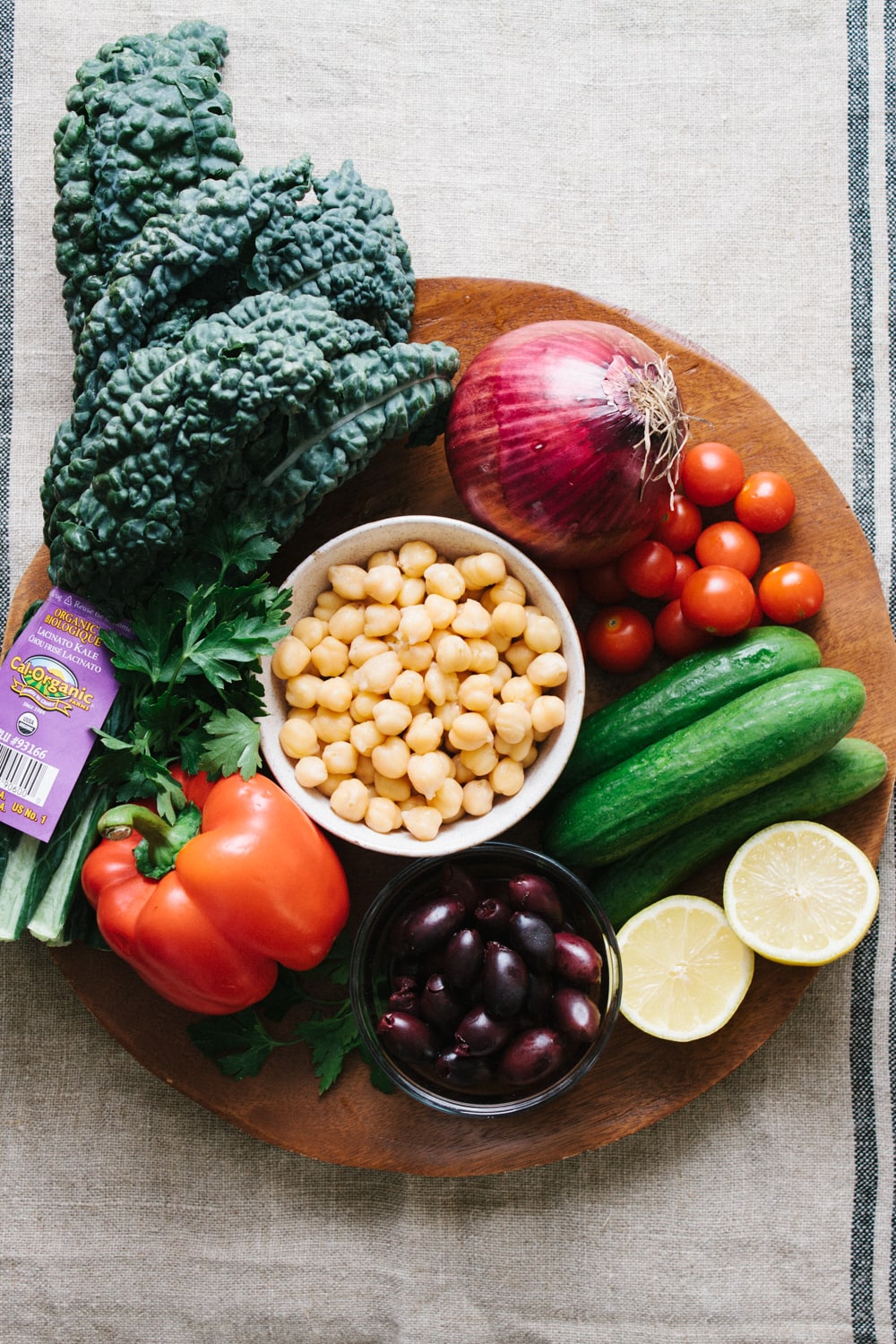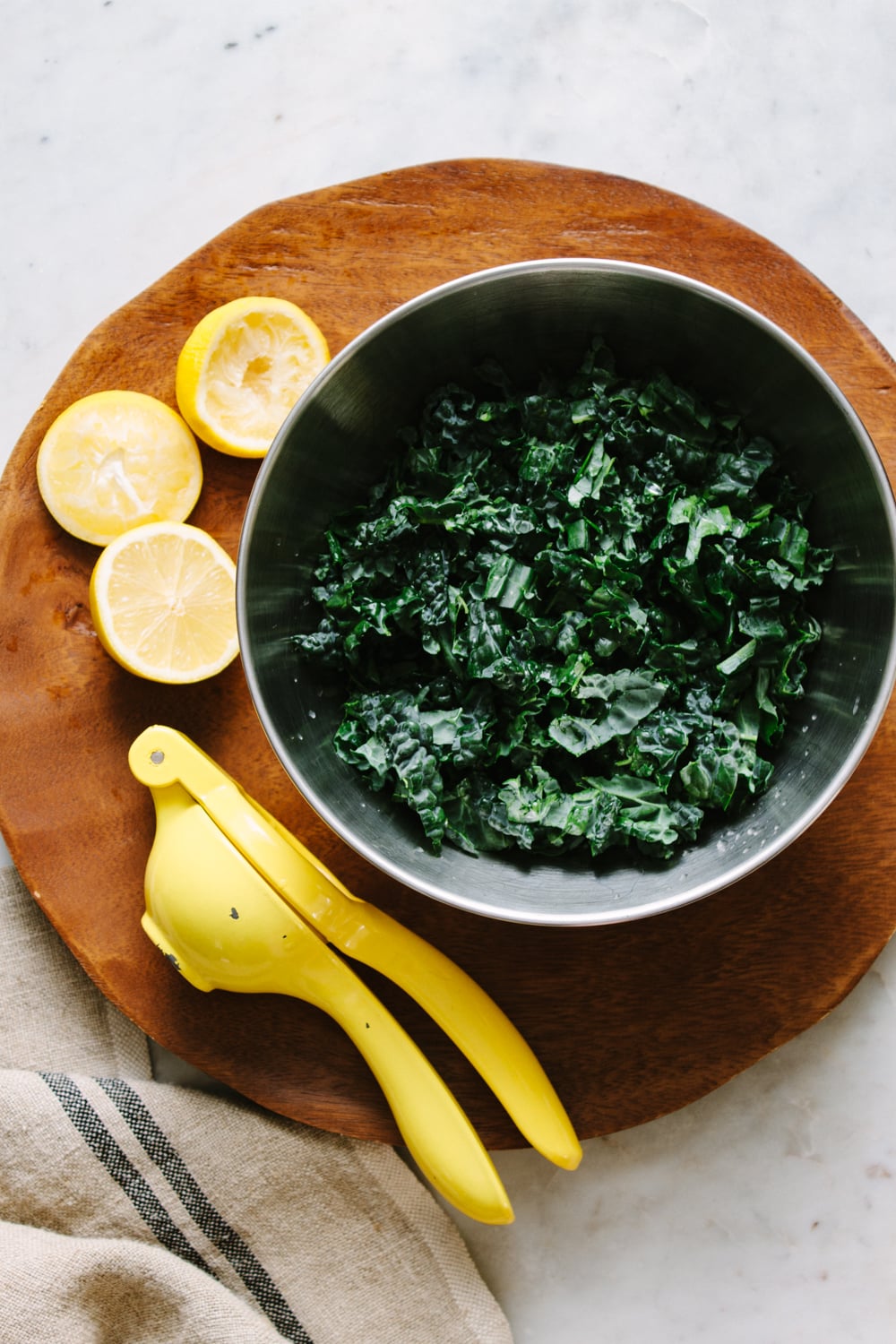Mediterranean Kale Salad
Mediterranean Kale Salad is filled with fresh kale and veggies and tossed in a flavorful vinaigrette for a hearty and healthy vegan salad that’s easy to make!

Summer is in full swing, and this Mediterranean-inspired Greek Kale Salad is just what I’ve been craving. It’s a simple, accessible, and inexpensive recipe that is good for you!
Made with mostly fresh ingredients, it’s colorful and delicious. I think you’ll love this recipe as much as we do!
So let’s uncook something wonderful!

Ingredients you’ll Need
The salad includes kale, lemon, red bell pepper, red onion, cucumber, cherry tomatoes, kalamata olives, chickpeas, hummus, and parsley.
The dressing consists of red wine vinegar, lemon, dijon, oregano, extra virgin olive oil, and salt and pepper.
Top Tips
- The dollop of hummus was an afterthought, but it was a delicious addition to the salad. It adds such nice creaminess and rounds out the salad well.
- If you find raw kale too hard to eat, even after letting it relax in lemon juice, a dollop of hummus will definitely do a world of good for you. It will help mask some of kale’s bitterness.
- In place of red wine vinegar, try subbing with apple cider or white wine vinegar.
- This Mediterranean kale salad dressing can easily be made oil-free by replacing it with lemon juice, vinegar, or water.

How To Make Mediterranean Kale Salad
- Marinate the kale (this is also known as massaging kale). Remove the stems from the center of the kale leaves, julienne the leaves, and place in a medium-sized bowl, with the juice of 1 large lemon, toss to coat the leaves and let set while you prepare the rest of the ingredients. The lemon juice will help soften the kale leaves, at least 10 – 15 minutes is good. Toss every few minutes or so to incorporate the lemon juice.

- In a small bowl, whisk together the red wine vinegar, lemon dijon, olive oil, oregano, salt, and pepper until emulsified. It usually takes me about one minute. Set aside.
- Once you’ve prepped your other ingredients you’re ready to assemble your kale salad. In a serving dish, add kale and top with bell pepper, onion, cucumber, tomatoes, olives, and chickpeas. Add your vinaigrette over top and a dollop of hummus anywhere you like.
And now you’re ready to enjoy!
How To Store
Any leftovers can be stored in the refrigerator for up to 3 days, either tossed with the dressing or kept separate.

More Healthy Salad Recipes!
- Vegan Caesar Salad
- Classic House Salad
- Vegan Cobb Salad
- See all vegan salad recipes on TSV!
If you try this easy kale recipe, please let me know! Leave a comment and rate it below. I love to hear what you think, or any changes you make.
PrintMEDITERRANEAN KALE SALAD
A healthy Greek kale salad with chickpeas, olives and other mediterranean flavors. Dressing can be made oil-free!
- Prep Time: 15 minutes
- Total Time: 15 minutes
- Yield: Serves 1
- Category: Salad
- Cuisine: Mediterranean
- Diet: Vegan
Ingredients
- 1 bunch kale, stems removed and julienned
- 1 large lemon, juice of
- 1 small red bell pepper, sliced
- 1/8 small red onion, sliced
- 1/2 cucumber, sliced
- 1/2 cup cherry tomatoes, sliced in half or campari tomatoes, quartered
- 1/3 cup kalamata olives, pitted
- 1 cup cooked chickpeas (garbanzo beans)
- dollop of hummus, optional (but so good!), to serve
- fresh chopped parsley, to serve
Vinaigrette
- 2 tablespoons red wine vinegar (apple cider or white wine vinegar is ok too)
- juice of 1 lemon
- 1 heaping teaspoon dijon mustard
- 1/4 teaspoon dried oregano, optional
- 1 tablespoon extra virgin olive oil
- salt & pepper, to taste
Instructions
Marinate the kale: Remove the stems from the center of the kale leaves, as least the thickest parts. Julienne kale leaves and place in a medium size bowl, add lemon juice, mix to coat the leaves and let set while you prepare the rest of the ingredients. The lemon juice will help soften the kale leaves. Toss every few minutes or so.
Dressing: In a small bowl, add the ingredients for the vinaigrette. Whisk together until emulsified. It usually takes me about one minute, set aside.
Assemble: Once you’ve prepped your other ingredients you’re ready to assemble your salad. In a serving dish, add kale and top with bell pepper, onion, cucumber, tomatoes, olives and chickpeas. Add your vinaigrette over top and a dollop of hummus anywhere you like.
Serves 2
Store: Leftovers can be stored in the refrigerator for up to 3 – 4 days in a covered container.
Notes
Depending on the size of your produce, amounts will vary. Adjust accordingly to suit your taste and situation. For instance, I used small Persian cucumbers here but used a whole small one. Typically, you’ll be using a regular or English cucumber and will only use about 1/4 of it, as per the recipe.
Make the dressing oil-free by omitting the oil and adding a little extra lemon juice, vinegar or water.
FOLLOW TSV on Facebook, Instagram, Pinterest, Youtube, Subscribe (email), or RSS for more recipes and inspiration!


Such a bright and tasty salad! This recipe is my new favorite thing! 🥰
I absolutely hate kale, so I subbed spinach. This is now my go-to salad dressing!
Beautiful & delicious!
I think I'm the chickpea's biggest fan so can't wait for the book!
This salad is exactly my kind of thing too :D
I think this is perfect salad for summer. I would like to try this my family :)
Hi Julie! What a perfect cookbook idea! Chickpeas are heavenly :) They seriously go with anything and everything. I'll be making this salad ASAP
Cannot wait for the cookbook Julie! It's right up my street and I know it's going to be awesome!
The salad looks fantastic too :)
A chickpea cookbook? Well that's good because i have 12 cans in the cupboard…
12 cans! You are definitely ready for this cookbook, and this salad!. :)
I love chickpeas, too! I think it's awesome that you're writing a book about them. :) This salad looks delicious! So many different flavors and consistencies.
Thank you Meredith! :)